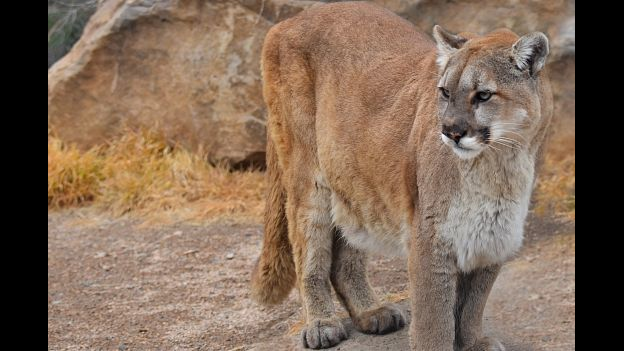Christmas and New Years Office Closure
Colorado Parks and Wildlife offices will be closed on December 24, December 25, December 26 and January 1.
Christmas and New Years Office Closure
Colorado Parks and Wildlife offices will be closed on December 24, December 25, December 26 and January 1.
The mountain lion is a magnificent hunter, rare to see in the wild due to their superior stealth skills.

The mountain lion is called by more names than any other Colorado mammal – cougar, puma, panther, catamount or just plain lion – and all connote respect for a magnificent hunter.
Why does CPW manage wildlife populations like mountain lions?
In Colorado, the projected statewide population size of independent lions (not including kittens) is around 3,800-4,400. Based on a preponderance of evidence, lion populations have grown in Colorado since 1965 when they were classified as a big game species. Once considered big game, mountain lions have benefited from regulations on take and management actions that have resulted in increasing populations.
Are mountain lion or bobcat populations threatened in any way in Colorado or the West?
Mountain lion populations are not biologically threatened. Mountain lions range from Northern Canada to the southern extent of South America. This represents the largest latitudinal range of any mammal in the Western Hemisphere. Both informal and recently collected empirical data suggest Colorado’s lion population is strong and lions are abundant in appropriate habitat. Further proof of a growing western lion population is the natural reestablishment of populations in the Dakotas and Nebraska over the past few decades, an expansion from source states.
What about the ecological services that lions and bobcats provide?
Healthy and robust lion and bobcat populations, which Colorado’s current management is designed to maintain, are important to functioning ecosystems. CPW values carnivores and their prominent role in our landscapes, and harvesting a sustainable number of carnivores each year doesn’t reduce the ecosystem services provided by the larger population.
CPW’s demonstrated track record of promoting and protecting strong mountain lion, bobcat and lynx populations across the state supports our mission of conserving wildlife and providing sustainable outdoor recreation opportunities that educate and inspire current and future generations to serve as active stewards of Colorado’s natural resources.
What scientific research and data has CPW collected on the current status of mountain lion populations in the state?
In 2020, CPW recognized its previous management scales didn’t align well with the movement of lions on the landscape, which is why CPW researchers and biologists made some changes in management practices in the West Slope Mountain Lion Plan. In this plan, CPW enacted two independent thresholds on the West Slope that keep lion populations from decreasing.
One limit is a cap on the total amount of human-caused mortality allowed each year; this includes all recorded mortalities like roadkill or agricultural conflicts and not just hunter harvest. Present levels of human-caused mortality under the West Slope plan are commonly cited as being sustainable and below levels believed by some to cause social disruption. The other independent plan threshold governs harvest composition (proportion of adult females in harvest) to make sure the population isn’t decreasing. With the West Slope plan well underway, CPW will soon be developing a similar plan for the eastern half of the state.
What studies are currently being done on lions in Colorado?
CPW has committed to a long-term plan of measuring lion density in two study areas per year across the West Slope for life of the West Slope plan; we are already moving on to our 3rd study area in January 2024. Additionally, CPW has a decade-long lion research project underway in the Upper Arkansas River drainage, testing to see if there is a relationship between human-lion conflict and changes in hunter harvest levels.
While mountain lions are generally an elusive animal who avoids interaction with humans, there are some common sense measures that can be taken to protect yourself and your pets when living in lion country.
Please read our Bobcats, Mountain Lions and Lynx FAQs (en español) for additional background information on this species.
Adult mountain lions are more than six feet long, with a graceful, black-tipped tail that is 32 inches long. They weigh 130 pounds or more. Color is reddish to buffy, with a paler underside.
Lions have the largest geographic range of any American native mammal other than humans – from western Canada to Argentina. Once they ranged from coast to coast in the United States, but today eastern populations are extinct or endangered; the West is their stronghold. Lions mainly live west of I-25 and in parts of SE Colorado. Lions living west of the Continental Divide in Colorado benefit from large areas of high-quality lion habitat due to severely limited accessibility.
In Colorado they are most abundant in foothills, canyons or mesa country. They are more at home in brushy areas and woodlands than in forests or open prairies.
Active year round, the lion’s staple diet is deer. Adults maintain their condition by eating a deer a week. Cougars hunt by stealth, often pouncing on prey from a tree or rock overhanging a game trail. The deer is often killed cleanly with a broken neck. The cat gorges on the carcass until it can eat no more, covers the remainder with leaves or conifer needles, then fasts for a few days, digesting and resting.
Mountain lions may breed at any time of year, but mating peaks in the spring. Births are most common in July, after a gestation period of about 14 weeks. Two or three spotted, fist-sized (about one pound) kittens are a typical litter. They are weaned about six weeks of age, at about eight times their birth weight.
